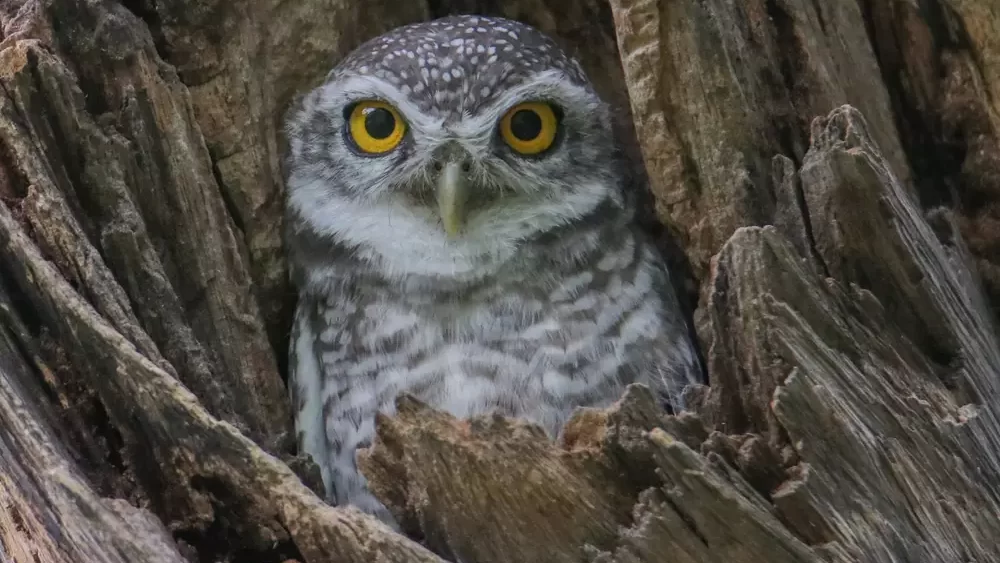Owls have captivated humans for centuries with their enigmatic presence and mesmerizing eyes.
These nocturnal raptors are both awe-inspiring and mysterious, making them a popular choice for animal enthusiasts who want to build a special bond with a unique creature.
But how does one tame an owl and build trust with this elusive bird of prey?
In this guide, we’ll explore the essential steps and techniques required for taming an owl and ensuring a successful partnership.
Understanding Owl Behavior
Before attempting to tame an owl, it’s crucial to understand their natural behaviors and instincts. Owls are predators, meaning they possess strong instincts to hunt and protect their territory.
They are also primarily nocturnal, which can make interaction and training more challenging.
Understanding these natural instincts is essential to creating a positive and productive relationship with your owl.
Choosing the Right Owl
Not all owl species are suited for taming. Some species are more amenable to human interaction than others.
When selecting an owl, consider factors like size, temperament, and the legal requirements for keeping an owl in your area.
It’s important to research different species and consult with experts to determine the best fit for your situation.
Creating a Safe and Comfortable Environment
Providing your owl with a safe and comfortable environment is essential to the taming process.
This includes an appropriate enclosure, perches, and nesting areas that cater to your owl’s specific needs.
A secure environment will help your owl feel at ease, making it more receptive to your efforts.

Establishing Trust Through Consistent Interaction
Building trust with your owl is the foundation of the taming process. This involves spending time with your owl each day, speaking to it gently, and offering treats to create positive associations.
Over time, your owl will learn to associate you with safety and comfort, laying the groundwork for successful training.
Using Positive Reinforcement to Train Your Owl
Positive reinforcement is a key component of owl taming. This involves rewarding your owl for desired behaviors and ignoring or redirecting undesired behaviors.
Food rewards, such as small pieces of meat, are particularly effective in reinforcing desired actions.
Implementing Desensitization Techniques
Gradually exposing your owl to new experiences and stimuli can help it adapt to its environment and become more comfortable with you.
Desensitization techniques involve introducing your owl to various objects, sounds, and experiences while maintaining a calm and reassuring presence.
Teaching Your Owl Basic Commands
Once trust has been established, you can begin teaching your owl basic commands, such as stepping onto your glove or returning to its perch.
Consistency, patience, and positive reinforcement are essential for success. Start with simple commands and gradually progress to more advanced training as your owl becomes more confident and responsive.

Developing a Strong Bond with Your Owl
A strong bond between you and your owl is vital for a successful taming experience. This bond is built through consistent interaction, positive reinforcement, and understanding your owl’s unique personality and needs.
By providing a nurturing and supportive environment, your owl will begin to view you as a trusted partner, further strengthening the bond between you.
Maintaining Good Health and Well-being
Keeping your owl healthy and well-cared for is essential to the taming process. This includes providing a balanced diet, clean water, and regular veterinary check-ups.
Monitoring your owl’s health and responding to any signs of illness or distress promptly can prevent serious issues and maintain a strong bond between you and your owl.
Dealing with Common Owl Behavioral Issues
During the taming process, you may encounter various behavioral challenges, such as aggression, fear, or possessiveness.
Addressing these issues calmly and assertively can help you maintain control and ensure a positive training experience.
Remember to stay patient, adapt your techniques as needed, and consult with experts if you encounter difficulties that you are unsure how to handle.
Frequently Asked Questions
Q: Is it legal to keep an owl as a pet?
A: Laws regarding keeping owls as pets vary depending on your location. In many countries, it is illegal to keep an owl without a specific license or permit.
Always research local regulations and consult with relevant authorities before acquiring an owl.
Q: How long does it take to tame an owl?
A: The time it takes to tame an owl varies depending on the individual bird, your skill and experience, and the techniques used.
Building trust and developing a strong bond with your owl can take weeks or even months. Patience, consistency, and commitment are essential for success.
Q: Can I train my owl to perform tricks or fly to my glove on command?
A: Yes, with proper training and positive reinforcement, owls can learn to perform a variety of behaviors, such as flying to your glove, perching on command, and even retrieving objects.
However, it’s important to remember that owls are not domesticated animals, and training should be focused on reinforcing natural behaviors rather than forcing them to perform unnatural tricks.
Final Thoughts
Taming an owl is a challenging and rewarding experience that requires patience, dedication, and a deep understanding of these fascinating creatures.
By following the steps outlined in this guide and respecting your owl’s natural instincts and boundaries, you can build a strong bond and embark on an unforgettable journey with your feathered companion.
Always remember to prioritize your owl’s well-being, seek expert advice when necessary, and above all, enjoy the unique privilege of sharing your life with one of nature’s most captivating birds of prey.